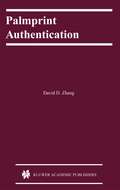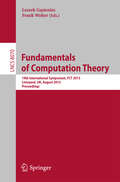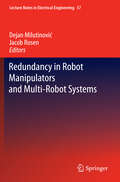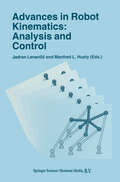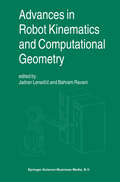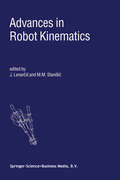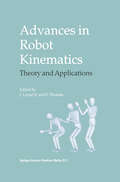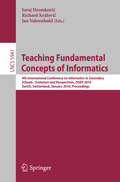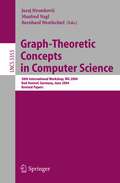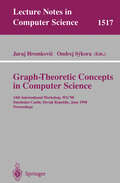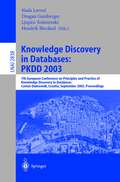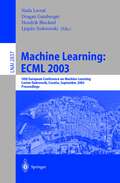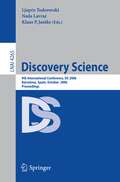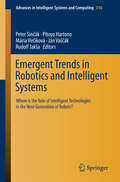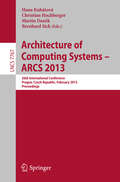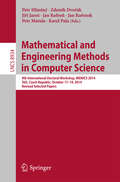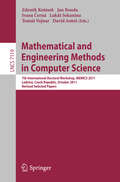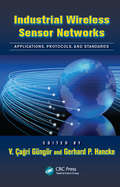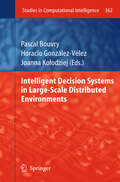- Table View
- List View
Geospatial Analysis with SQL: A hands-on guide to performing geospatial analysis by unlocking the syntax of spatial SQL
by Bonny PLeverage the power of SQL to perform geospatial analysis and increase your speed and efficiency working with a variety of spatial applications such as PostGIS and QGISKey FeaturesFollow along with actionable instructions with this practical guideBecome well-versed in advanced spatial modeling and machine learning techniquesLearn best practices for performing spatial analysis from an expert spatial data analystBook DescriptionGeospatial analysis is industry agnostic and a powerful tool for answering location questions. Combined with the power of SQL, developers and analysts worldwide rely on database integration to solve real-world spatial problems. This book introduces skills to help you detect and quantify patterns in datasets through data exploration, visualization, data engineering, and the application of analysis and spatial techniques. You will begin by exploring the fundamentals of geospatial analysis where you’ll learn about the importance of geospatial analysis and how location information enhances data exploration. Walter Tobler’s second law of geography states, “the phenomenon external to a geographic area of interest affects what goes on inside.” This quote will be the framework of the geospatial questions we will explore. You’ll then observe the framework of geospatial analysis using SQL while learning to create spatial databases and SQL queries and functions. By the end of this book, you will have an expanded toolbox of analytic skills such as PostGIS and QGIS to explore data questions and analysis of spatial information.What you will learnUnderstand geospatial fundamentals as a basis for learning spatial SQLGenerate point, line, and polygon data with SQLUse spatial data types to abstract and encapsulate spatial structuresWork with open source GIS combined with plug-insVisualize spatial data and expand QGIS functionality with PostgresApply location data to leverage spatial analyticsPerform single-layer and multiple-layer spatial analysesWho this book is forThis book is for anyone looking to leverage their SQL knowledge to perform geospatial analysis. GIS analysts, data analysts, and data scientists with a basic understanding of both geospatial analysis and SQL will find this book useful.
100% Unofficial Roblox Mega Hits 3
by 100% UnofficialOVER 15 MORE OF ROBLOX’S BEST GAMES INSIDE FOR YOU TO EXPLORE
Managing the Digital Workplace in the Post-Pandemic: A Companion for Study and Practice
by Fahri 1254 ZsungurManaging the Digital Workplace in the Post-Pandemic provides a cutting-edge survey of digital organizational behaviour in the post-pandemic workplace, drawing from an international range of expertise. It introduces and guides students and practitioners through the current best practices, laboratory methods, policies and protocols in use during these times of rapid change to workplace practices. This book is essential reading for students, researchers and practitioners in business and management. The book draws on global expertise from its contributors while being suitable for class and educational use, with each chapter including further reading, chapter summaries and exercises. Tutors are supported with a set of instructor materials that include PowerPoint slides, a test bank and an instructor's manual. This text covers a wide range of themes in this fast-developing field, including: The effect of the pandemic on the digital workplace Gender and cyberbullying in the context of the digital workplace Digital ergonomics and productivity Digital conflict management
Palmprint Authentication (International Series on Biometrics #3)
by 8#, Xingyi 16/F, Maxdo CenterPalmprint Authentication is the first book to provide a comprehensive introduction to palmprint technologies. It reveals automatic biometric techniques for personal identification using palmprint, from the approach based on offline palmprint images, to the current state-of-the-art algorithm using online palmprint images. Palmprint Authentication provides the reader with a basic concept of Palmprint Authentication. It also includes an in-depth discussion of Palmprint Authentication technologies, a detailed description of Palmprint Authentication systems, and an up-to-date coverage of how these issues are developed. This book is suitable for different levels of readers: those who want to learn more about palmprint technology, and those who wish to understand, participate, and/or develop a palmprint authentication system. Palmprint Authentication is effectively a handbook for biometric research and development. Graduate students and researchers in computer science, electrical engineering, systems science, and information technology will all find it uniquely useful, not only as a reference book, but also as a text book. Researchers and practitioners in industry, and R&D laboratories working in the fields of security system design, biometrics, immigration, law enforcement, control, and pattern recognition will also benefit from this volume.
Photo Inspiration: Secrets Behind Stunning Images
by 1x.comThe inspiration you need to help improve your photography skills Well-known for their stunning world-class photography, 1x.com has worked with their most talented photographers to handpick 100 awe-inspiring images and provided the back-story and photographer's secrets that helped capture them. This book presents you with inspiration as well as underlying techniques that can help improve your photography skills immediately. Shares behind-the-scene stories of the featured photos from the photographers themselves, from their artistic vision to the technical details that went into each shot Offers clear, concise, and accessible descriptions for the ideas, vision, performance, setup, location, equipment, camera settings, lighting diagrams, and image editing methods of each amazing photo Photo Inspiration provides a unique combination of the final photograph with the tools and knowledge that made it possible, all of which are aimed at helping you meet your photographic potential.
Photo Inspiration: Secrets Behind Stunning Images
by 1x.comThe inspiration you need to help improve your photography skills Well-known for their stunning world-class photography, 1x.com has worked with their most talented photographers to handpick 100 awe-inspiring images and provided the back-story and photographer's secrets that helped capture them. This book presents you with inspiration as well as underlying techniques that can help improve your photography skills immediately. Shares behind-the-scene stories of the featured photos from the photographers themselves, from their artistic vision to the technical details that went into each shot Offers clear, concise, and accessible descriptions for the ideas, vision, performance, setup, location, equipment, camera settings, lighting diagrams, and image editing methods of each amazing photo Photo Inspiration provides a unique combination of the final photograph with the tools and knowledge that made it possible, all of which are aimed at helping you meet your photographic potential.
Fundamentals of Computation Theory: 19th International Symposium, FCT 2013, Liverpool, UK, August 19-21, 2013, Proceedings (Lecture Notes in Computer Science #8070)
by Leszek G 261 Sieniec Frank WolterThis book constitutes the refereed proceedings of the 19th International Symposium on Fundamentals of Computation Theory, FCT 2013, held in Liverpool, UK, in August 2013. The 29 papers (26 full papers and 3 invited papers) were carefully reviewed and selected from 58 submissions. The papers cover the following topics: algorithms, formal methods, and emerging fields.
Redundancy in Robot Manipulators and Multi-Robot Systems (Lecture Notes in Electrical Engineering #57)
by Dejan Milutinovi 263 Jacob RosenThe trend in the evolution of robotic systems is that the number of degrees of freedom increases. This is visible both in robot manipulator design and in the shift of focus from single to multi-robot systems. Following the principles of evolution in nature, one may infer that adding degrees of freedom to robot systems design is beneficial. However, since nature did not select snake-like bodies for all creatures, it is reasonable to expect the presence of a certain selection pressure on the number of degrees of freedom. Thus, understanding costs and benefits of multiple degrees of freedom, especially those that create redundancy, is a fundamental problem in the field of robotics.This volume is mostly based on the works presented at the workshop on Redundancy in Robot Manipulators and Multi-Robot Systems at the IEEE/RSJ International Conference on Intelligent Robots and Systems - IROS 2011. The workshop was envisioned as a dialog between researchers from two separate, but obviously related fields of robotics: one that deals with systems having multiple degrees of freedom, including redundant robot manipulators, and the other that deals with multirobot systems. The volume consists of twelve chapters, each representing one of the two fields.
Advances in Robot Kinematics: Analysis and Control
by Jadran Lenar 269 I 269 Manfred L. HustyThe contributions in this book were presented at the sixth international symposium on Advances in Robot Kinematics organised in June/July 1998 in Strobl/Salzburg in Austria. The preceding symposia of the series took place in Ljubljana (1988), Linz (1990), Ferrara (1992), Ljubljana (1994), and Piran (1996). Ever since its first event, ARK has attracted the most outstanding authors in the area and managed to create a perfect combination of professionalism and friendly athmosphere. We are glad to observe that, in spite of a strong competition of many international conferences and meetings, ARK is continuing to grow in terms of the number of participants and in terms of its scientific impact. In its ten years, ARK has contributed to develop a remarkable scientific community in the area of robot kinematics. The last four symposia were organised under the patronage of the International Federation for the Theory of Machines and Mechanisms -IFToMM. interest to researchers, doctoral students and teachers, The book is of engineers and mathematicians specialising in kinematics of robots and mechanisms, mathematical modelling, simulation, design, and control of robots. It is divided into sections that were found as the prevalent areas of the contemporary kinematics research. As it can easily be noticed, an important part of the book is dedicated to various aspects of the kinematics of parallel mechanisms that persist to be one of the most attractive areas of research in robot kinematics.
Advances in Robot Kinematics and Computational Geometry
by Jadran Lenar 269 I 269 Bahram RavaniRecently, research in robot kinematics has attracted researchers with different theoretical profiles and backgrounds, such as mechanical and electrica! engineering, computer science, and mathematics. It includes topics and problems that are typical for this area and cannot easily be met elsewhere. As a result, a specialised scientific community has developed concentrating its interest in a broad class of problems in this area and representing a conglomeration of disciplines including mechanics, theory of systems, algebra, and others. Usually, kinematics is referred to as the branch of mechanics which treats motion of a body without regard to the forces and moments that cause it. In robotics, kinematics studies the motion of robots for programming, control and design purposes. It deals with the spatial positions, orientations, velocities and accelerations of the robotic mechanisms and objects to be manipulated in a robot workspace. The objective is to find the most effective mathematical forms for mapping between various types of coordinate systems, methods to minimise the numerical complexity of algorithms for real-time control schemes, and to discover and visualise analytical tools for understanding and evaluation of motion properties ofvarious mechanisms used in a robotic system.
Advances in Robot Kinematics
by Jadran Lenar 269 I 269 M. M. StanisicThis book presents the most recent research advances in the theory, design, control and application of robotic systems, which are intended for a variety of purposes such as manipulation, manufacturing, automation, surgery, locomotion and biomechanics. The issues addressed are fundamentally kinematic in nature, including synthesis, calibration, redundancy, force control, dexterity, inverse and forward kinematics, kinematic singularities, as well as over-constrained systems. Methods used include line geometry, quaternion algebra, screw algebra, and linear algebra. These methods are applied to both parallel and serial multi-degree-of-freedom systems. The results should interest researchers, teachers and students, in fields of engineering and mathematics related to robot theory, design, control and application. All articles in the book were reported at the seventh international symposium on Advances in Robot Kinematics that was organised in June 2000 in the beautiful ancient Mediterranean town of Piran in Slovenia. The preceding symposia of the series took place in Ljubljana (1988), Linz (1990), Ferrara (1992), Ljubljana (1994), and Piran (1996), and Salzburg (1998).
Advances in Robot Kinematics: Theory and Applications
by Jadran Lenar 269 I 269 Federico ThomasThis book presents the most recent research advances in the theory, design, control, and application of robotic systems, which are intended for a variety of purposes such as manipulation, manufacturing, automation, surgery, locomotion, and biomechanics.
Teaching Fundamental Concepts of Informatics: 4th International Conference on Informatics in Secondary Schools - Evolution and Perspectives, ISSEP 2010, Zurich, Switzerland, January 13-15, 2010, Proceedings (Lecture Notes in Computer Science #5941)
by Juraj Hromkovi 269 Rastislav Královic Jan VahrenholdThe International Conference on Informatics in Secondary Schools: Evolution and Perspective (ISSEP) is an emerging forum for researchers and practitioners in the area of computer science education with a focus on secondary schools. The ISSEP series started in 2005 in Klagenfurt, and continued in 2006 in Vilnius, and in 2008 in Torun. ´ The 4th ISSEP took part in Zurich. This volume presents 4 of the 5 invited talks and 14 regular contributions chosen from 32 submissions to ISSEP 2010. The ISSEP conference series is devoted to all aspects of computer science teaching. In the preface of the proceedings of ISSEP 2006, Roland Mittermeir wrote: “ISSEP aims at educating ‘informatics proper’ by showing the beauty of the discipline, hoping to create interest in a later professional career in c- puting, and it will give answers di?erent from the opinion of those who used to familiarize pupils with the basics of ICT in order to achieve computer lit- acy for the young generation. ” This is an important message at this time, when several countries have reduced teaching informatics to educating about current softwarepackagesthatchangefromyeartoyear. ThegoalofISSEPistosupport teaching of the basic concepts and methods of informatics, thereby making it a subject in secondary schools that is comparable in depth and requirements with mathematics or natural sciences. As we tried to present in our book “Algori- mic Adventures.
Graph-Theoretic Concepts in Computer Science: 30th International Workshop, WG 2004, Bad Honnef, Germany, June 21-23, 2004, Revised Papers (Lecture Notes in Computer Science #3353)
by Juraj Hromkovi 269 Manfred Nagl Bernhard WestfechtelDuring its 30-year existence, the International Workshop on Graph-Theoretic Concepts in Computer Science has become a distinguished and high-quality computer science event. The workshop aims at uniting theory and practice by demonstrating how graph-theoretic concepts can successfully be applied to v- ious areas of computer science and by exposing new theories emerging from applications. In this way, WG provides a common ground for the exchange of information among people dealing with several graph problems and working in various disciplines. Thereby, the workshop contributes to forming an interdis- plinary research community. The original idea of the Workshop on Graph-Theoretic Concepts in C- puter Science was ingenuity in all theoretical aspects and applications of graph concepts, wherever applied. Within the last ten years, the development has strengthened in particular the topic of structural graph properties in relation to computational complexity. This workshop has become pivotal for the c- munity interested in these areas.An aimspeci?c to the 30thWG was to support the central role of WG in both of the prementioned areas on the one hand and on the other hand to promote its originally broader scope. The 30th WG was held at the Physikzentrum Bad Honnef, which serves as the main meeting point of the German Physical Society. It o?ers a secluded setting for research conferences, seminars, and workshops, and has proved to be especiallystimulatingforfruitful discussions.Talksweregiveninthenewlecture hall with a modern double rear projection, interactive electronic board, and full video conferencing equipment.
Graph-Theoretic Concepts in Computer Science: 24th International Workshop, WG'98, Smolenice Castle, Slovak Republic, June 18-20, Proceedings (Lecture Notes in Computer Science #1517)
by Juraj Hromkovi 269 Ondrej SykoraKnowledge Discovery in Databases: 7th European Conference on Principles and Practice of Knowledge Discovery in Databases, Cavtat-Dubrovnik, Croatia, September 22-26, 2003, Proceedings (Lecture Notes in Computer Science #2838)
by Nada Lavra 269 Dragan Gamberger Hendrik Blockeel Ljupco TodorovskiThe proceedings of ECML/PKDD2003 are published in two volumes: the P- ceedings of the 14th European Conference on Machine Learning (LNAI 2837) and the Proceedings of the 7th European Conference on Principles and Practice of Knowledge Discovery in Databases (LNAI 2838). The two conferences were held on September 22–26, 2003 in Cavtat, a small tourist town in the vicinity of Dubrovnik, Croatia. As machine learning and knowledge discovery are two highly related ?elds, theco-locationofbothconferencesisbene?cialforbothresearchcommunities.In Cavtat, ECML and PKDD were co-located for the third time in a row, following the successful co-location of the two European conferences in Freiburg (2001) and Helsinki (2002). The co-location of ECML2003 and PKDD2003 resulted in a joint program for the two conferences, including paper presentations, invited talks, tutorials, and workshops. Out of 332 submitted papers, 40 were accepted for publication in the ECML2003proceedings,and40wereacceptedforpublicationinthePKDD2003 proceedings. All the submitted papers were reviewed by three referees. In ad- tion to submitted papers, the conference program consisted of four invited talks, four tutorials, seven workshops, two tutorials combined with a workshop, and a discovery challenge.
Machine Learning: 14th European Conference on Machine Learning, Cavtat-Dubrovnik, Croatia, September 22-26, 2003, Proceedings (Lecture Notes in Computer Science #2837)
by Nada Lavra 269 Dragan Gamberger Ljupco Todorovski Hendrik BlockeelThe proceedings of ECML/PKDD2003 are published in two volumes: the P- ceedings of the 14th European Conference on Machine Learning (LNAI 2837) and the Proceedings of the 7th European Conference on Principles and Practice of Knowledge Discovery in Databases (LNAI 2838). The two conferences were held on September 22–26, 2003 in Cavtat, a small tourist town in the vicinity of Dubrovnik, Croatia. As machine learning and knowledge discovery are two highly related ?elds, theco-locationofbothconferencesisbene?cialforbothresearchcommunities.In Cavtat, ECML and PKDD were co-located for the third time in a row, following the successful co-location of the two European conferences in Freiburg (2001) and Helsinki (2002). The co-location of ECML2003 and PKDD2003 resulted in a joint program for the two conferences, including paper presentations, invited talks, tutorials, and workshops. Out of 332 submitted papers, 40 were accepted for publication in the ECML2003proceedings,and40wereacceptedforpublicationinthePKDD2003 proceedings. All the submitted papers were reviewed by three referees. In ad- tion to submitted papers, the conference program consisted of four invited talks, four tutorials, seven workshops, two tutorials combined with a workshop, and a discovery challenge.
Discovery Science: 9th International Conference, DS 2006, Barcelona, Spain, October 7-10, 2006, Proceedings (Lecture Notes in Computer Science #4265)
by Nada Lavra 269 Ljupco Todorovski Klaus P. JantkeThis book constitutes the refereed proceedings of the 9th International Conference on Discovery Science, DS 2006, held in Barcelona, Spain in October 2006, co-located with the 17th International Conference on Algorithmic Learning Theory, ALT 2006. The 23 revised long papers and the 18 revised regular papers presented together with five invited papers were carefully reviewed and selected from 87 submissions.
Emergent Trends in Robotics and Intelligent Systems: Where is the Role of Intelligent Technologies in the Next Generation of Robots? (Advances in Intelligent Systems and Computing #316)
by Peter Sin 269 Ák Pitoyo Hartono Mária Vir 269 Íková Ján Vas 269 Rudolf JaksaWhat is the Role of Intelligent Technologies in the Next Generation of Robots ? This monograph gives answers to this question and presents emergent trends of Intelligent Systems and Robotics. After an introductory chapter celebrating 70 year of publishing the McCulloch Pitts model the book consists of the 2 parts „Robotics“ and „Intelligent Systems“. The aim of the book is to contribute to shift conventional robotics in which the robots perform repetitive, pre-programmed tasks to its intelligent form, where robots possess new cognitive skills with ability to learn and adapt to changing environment. A main focus is on Intelligent Systems, which show notable achievements in solving various problems in intelligent robotics. The book presents current trends and future directions bringing together Robotics and Computational Intelligence. The contributions include widespread experimental and theoretical results on intelligent robotics such as e.g. autonomous robotics, new robotic platforms, or talking robots.
Impact of Industry 4.0 on Sustainable Tourism: Perspectives, Challenges and Future
by Zuzana Tu 269 Ková Sandeep Kumar Dey Hoc Huynh Thai Sinh Duc HoangThe tourism and hospitality industry is at the forefront of the climate crisis as a significant source of carbon emissions on a global scale. There is a need to disseminate opportunities and explore scientific avenues in emerging technologies associated with industry 4.0 , such as artificial intelligence, virtual and augmented reality, ‘extended reality’ or the use of service robots, and forecasting future trends in the tourism industry’s fight against the climate crisis. Translating these current and future problems into pragmatic solutions, the chapter authors explore the opportunities for both academia and industry in agile and disruptive technologies. By integrating unique features of these advancements like Extended Reality (XR), Machine Intelligence (MI) and Computer Vision (CV), Impact of Industry 4.0 on Sustainable Tourism determines the trajectory of sustainable tourism development. Of interest to both academics and practitioners, Impact of Industry 4.0 on Sustainable Tourism reveals patterns and projections to provide a discourse on the progression of disruptive and futuristic technologies in the field of sustainable tourism research and practice.
Architecture of Computing Systems -- ARCS 2013: 26th International Conference, Prague, Czech Republic, February 19-22, 2013 Proceedings (Lecture Notes in Computer Science #7767)
by Martin Dan 283 K Bernhard Sick Hana Kubatova Christian HochbergerThis book constitutes the refereed proceedings of the 26th International Conference on Architecture of Computing Systems, ARCS 2013, held in Prague, Czech Republic, in February 2013. The 29 papers presented were carefully reviewed and selected from 73 submissions. The topics covered are computer architecture topics such as multi-cores, memory systems, and parallel computing, adaptive system architectures such as reconfigurable systems in hardware and software, customization and application specific accelerators in heterogeneous architectures, organic and autonomic computing including both theoretical and practical results on self-organization, self-configuration, self-optimization, self-healing, and self-protection techniques, operating systems including but not limited to scheduling, memory management, power management, RTOS, energy-awareness, and green computing.
Mathematical and Engineering Methods in Computer Science: 9th International Doctoral Workshop, MEMICS 2014, Telč, Czech Republic, October 17--19, 2014, Revised Selected Papers (Lecture Notes in Computer Science #8934)
by Petr Hlin 283 Ný Zden 283 K Dvo 345 Ák Ji 345 Í Jaros Jan Kofro 328 Jan Ko 345 Enek Petr Matula Karel PalaThis volume contains the post-proceedings of the 9th Doctoral Workshop on Mathematical and Engineering Methods in Computer Science, MEMICS 2014, held in Telč, Czech Republic, in October 2014.The 13 thoroughly revised papers were carefully selected out of 28 submissions and are presented together with 4 invited papers. The topics covered by the papers include: algorithms, logic, and games; high performance computing; computer aided analysis, verification, and testing; hardware design and diagnostics; computer graphics and image processing; and artificial intelligence and natural language processing.
Mathematical and Engineering Methods in Computer Science: 7th International Doctoral Workshop, MEMICS 2011, Lednice, Czech Republic, October 14-16, 2011, Revised Selected Papers (Lecture Notes in Computer Science #7119)
by Zden 283 K Kotásek Jan Bouda Ivana Cerná Lukas Sekanina Tomás Vojnar David AntosThis volume constitutes the thoroughly refereed post-conference proceedings of the 7th International Doctoral Workshop on Mathematical and Engineering Methods in Computer Science, MEMICS 2011, held in Lednice, Czech Republic, on October 14-16, 2011. The 13 revised full papers presented together with 6 invited talks were carefully reviewed and selected from 38 submissions. The papers address all current issues of mathematical and engineering methods in computer science, especially: software and hardware dependability, computer security, computer-aided analysis and verification, testing and diagnostics, simulation, parallel and distributed computing, grid computing, computer networks, modern hardware and its design, non-traditional computing architectures, software engineering, computational intelligence, quantum information processing, computer graphics and multimedia, signal, text, speech, and image processing, and theoretical computer science.
Industrial Wireless Sensor Networks: Applications, Protocols, and Standards (Industrial Electronics)
by V. Ça 287 R 305 Güngör Gerhard P. HanckeThe collaborative nature of industrial wireless sensor networks (IWSNs) brings several advantages over traditional wired industrial monitoring and control systems, including self-organization, rapid deployment, flexibility, and inherent intelligent processing. In this regard, IWSNs play a vital role in creating more reliable, efficient, and productive industrial systems, thus improving companies’ competitiveness in the marketplace. Industrial Wireless Sensor Networks: Applications, Protocols, and Standards examines the current state of the art in industrial wireless sensor networks and outlines future directions for research. What Are the Main Challenges in Developing IWSN Systems? Featuring contributions by researchers around the world, this book explores the software and hardware platforms, protocols, and standards that are needed to address the unique challenges posed by IWSN systems. It offers an in-depth review of emerging and already deployed IWSN applications and technologies, and outlines technical issues and design objectives. In particular, the book covers radio technologies, energy harvesting techniques, and network and resource management. It also discusses issues critical to industrial applications, such as latency, fault tolerance, synchronization, real-time constraints, network security, and cross-layer design. A chapter on standards highlights the need for specific wireless communication standards for industrial applications. A Starting Point for Further Research Delving into wireless sensor networks from an industrial perspective, this comprehensive work provides readers with a better understanding of the potential advantages and research challenges of IWSN applications. A contemporary reference for anyone working at the cutting edge of industrial automation, communication systems, and networks, it will inspire further exploration in this promising research area.
Intelligent Decision Systems in Large-Scale Distributed Environments (Studies in Computational Intelligence #362)
by Joanna Ko 322 Odziej Pascal Bouvry Horacio González-VélezOne of the most challenging issues for the intelligent decision systems is to effectively manage the large-scale complex distributed environments such as computational clouds, grids, ad hoc and P2P networks, under the different types of users, their relations, and real-world uncertainties. In this context the IT resources and services usually belong to different owners (institutions, enterprises, or individuals) and are managed by different administrators. These administrators conform to different sets of rules and configuration directives, and can impose different usage policies on the system users. Additionally, uncertainties are presented in various types of information that are incomplete, imprecise, fragmentary or overloading, which hinders the full and precise determination of the evaluation criteria, their subsequent and selection, the assignment scores, and eventually the final integrated decision result.This book presents new ideas, analysis, implementations and evaluation of the next generation intelligent techniques for solving complex decision problems in large-scale distributed systems. In 15 chapters several important formulations of the decision problems in heterogeneous environments are identified and a review of the recent approaches, from game theoretical models and computational intelligent techniques, such as genetic, memetic and evolutionary algorithms, to intelligent multi-agent systems and networking are presented. We believe that this volume will serve as a reference for the students, researchers and industry practitioners working in or are interested in joining interdisciplinary works in the areas of intelligent decision systems using emergent distributed computing paradigms. It will also allow newcomers to grasp key concerns and potential solutions on the selected topics.



